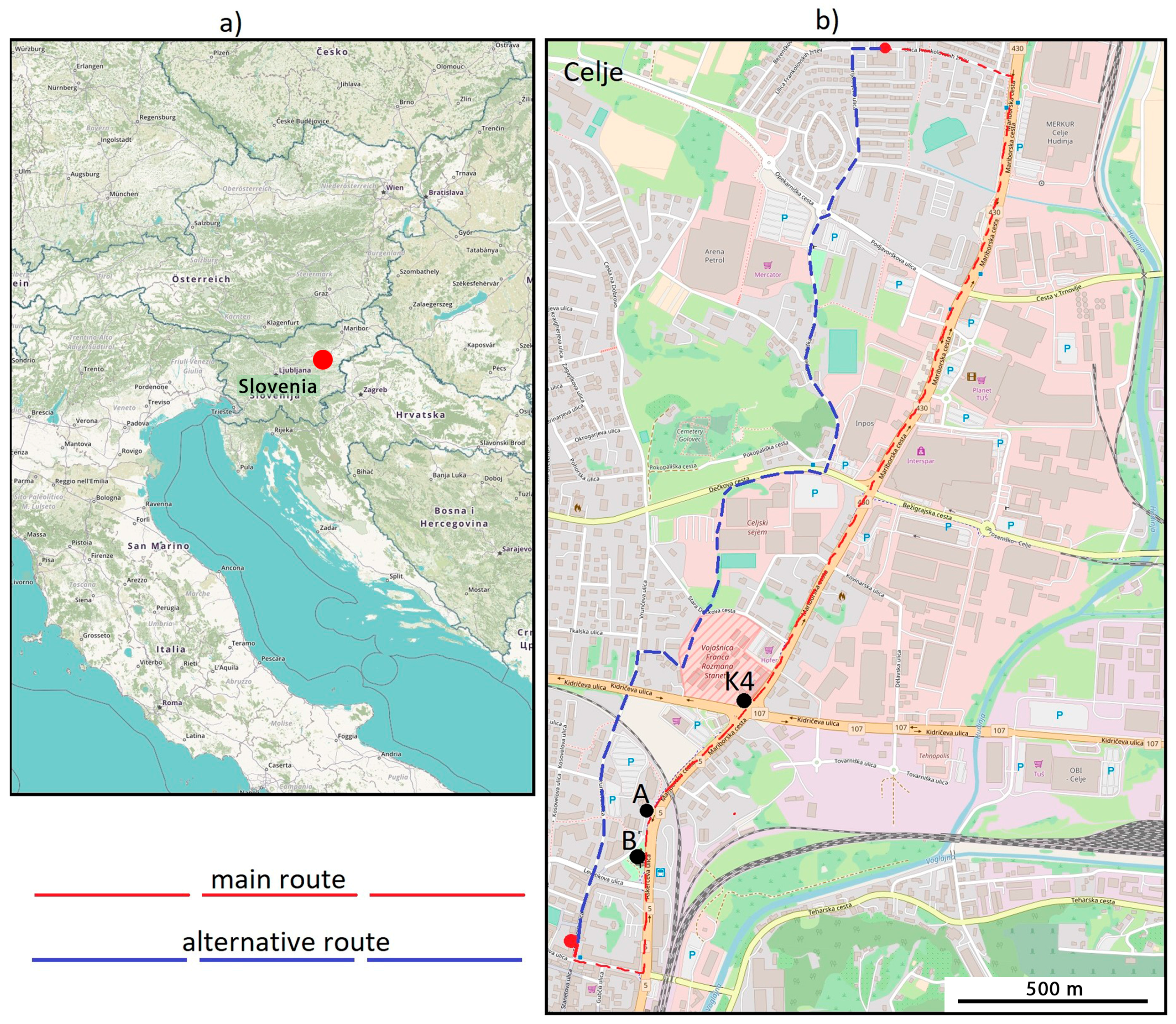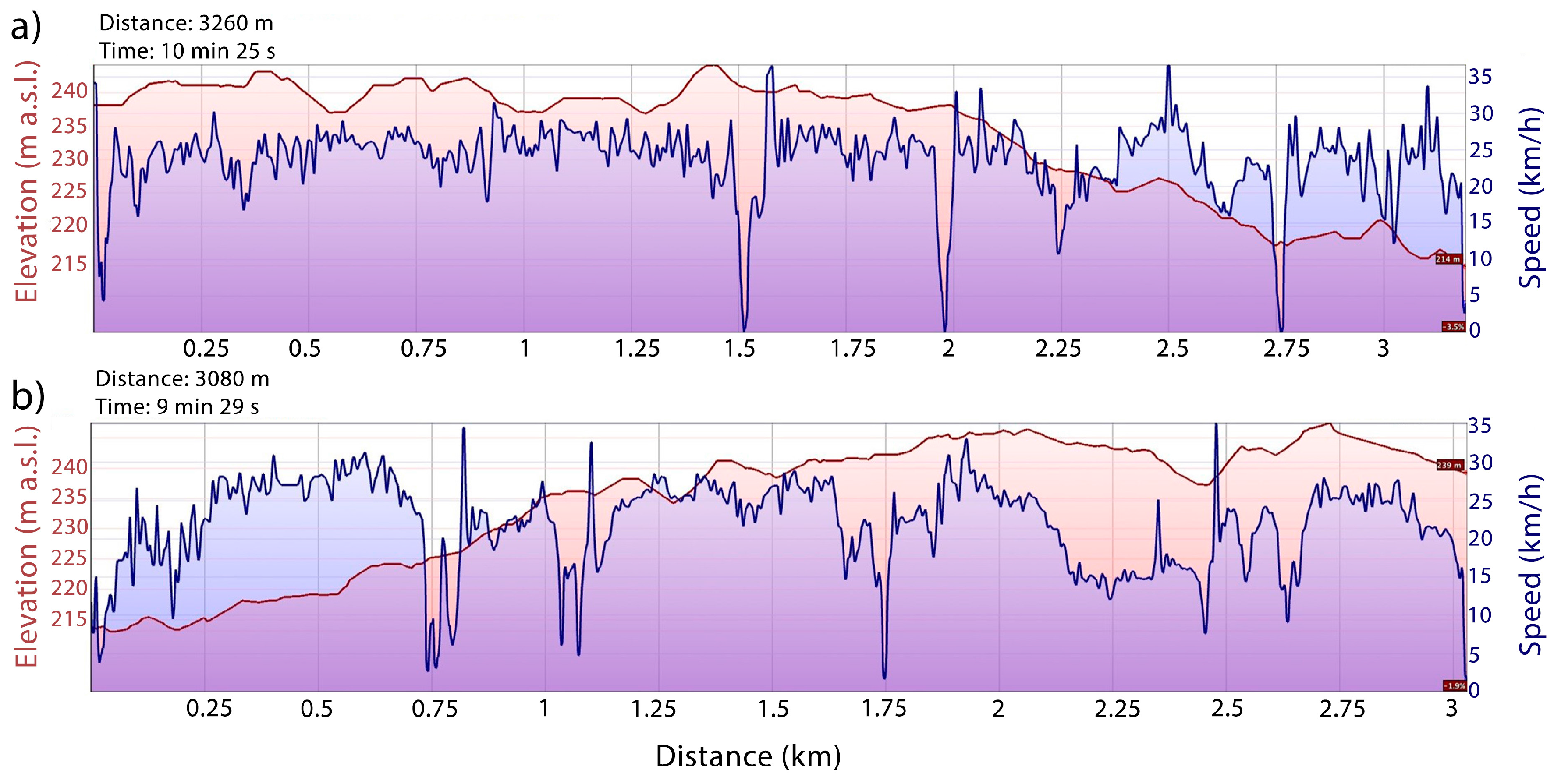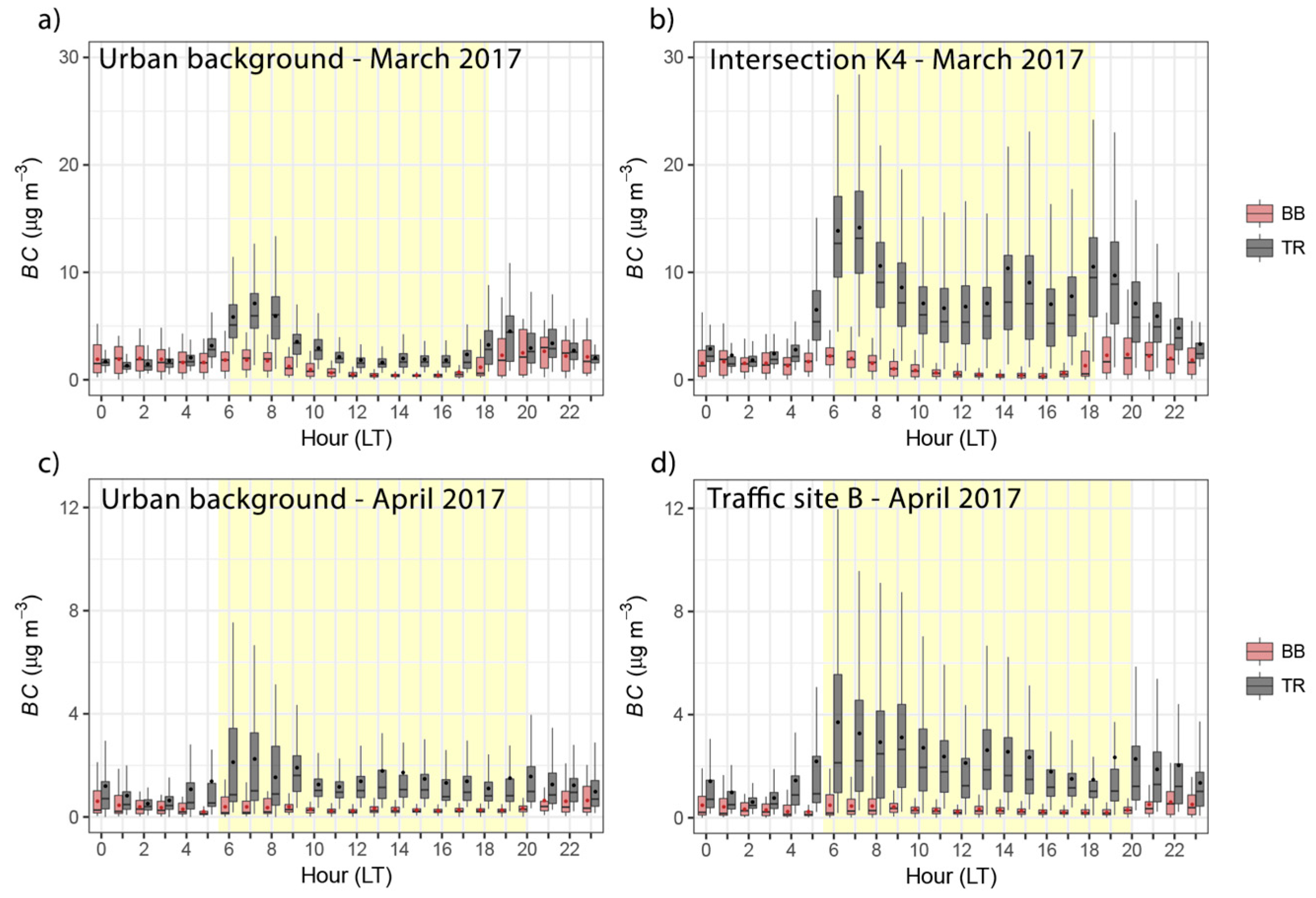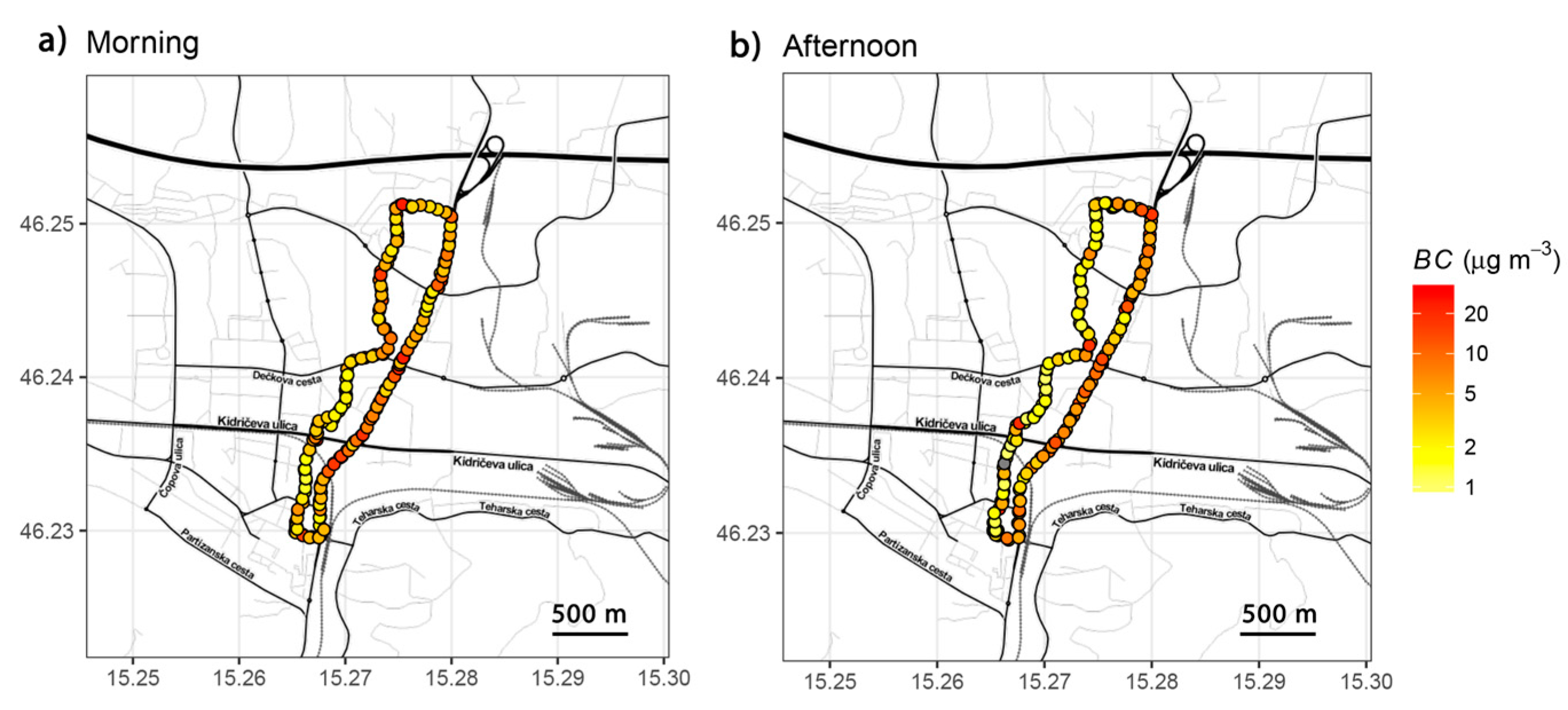Exposure to Black Carbon during Bicycle Commuting–Alternative Route Selection
Abstract
:1. Introduction
2. Methods
2.1. Measurement Locations
2.2. Measurement Set-Up and Instrumentation
3. Results and Discussion
3.1. Traffic Density
3.2. Temporal Evolution of BC Concentrations and Their Spatial Distribution
3.3. The Influence of Cycling Route on Inhalation Exposure to Traffic Related BC
4. Conclusions
Acknowledgments
Author Contributions
Conflicts of Interest
References
- World Health Organization (WHO). Health Effects of Black Carbon; The WHO European Centre for Environment and Health: Bonn, Germany, 2012; p. 86. [Google Scholar]
- Janssen, N.A.; Hoek, G.; Simic-Lawson, M.; Fischer, P.; van Bree, L.; ten Brink, H.; Keuken, M.; Atkinson, R.W.; Anderson, H.R.; Brunekreef, B.; et al. Black carbon as an additional indicator of the adverse health effects of airborne particles compared with PM10 and PM2.5. Environ. Health Perspect. 2011, 119, 1691–1699. [Google Scholar] [CrossRef] [PubMed]
- Morawska, L.; Ristovski, Z.; Jayaratne, E.R.; Keogh, D.U.; Ling, X. Ambient nano and ultrafine particles from motor vehicle emissions: Characteristics, ambient processing and implications on human exposure. Atmos. Environ. 2008, 42, 8113–8138. [Google Scholar] [CrossRef] [Green Version]
- Marshall, J.D.; McKone, T.E.; Deakin, E.; Nazaroff, W.W. Inhalation of motor vehicle emissions: Effects of urban population and land area. Atmos. Environ. 2005, 39, 283–295. [Google Scholar] [CrossRef]
- Klems, J.P.; Pennington, M.R.; Zordan, C.A.; Johnston, M.V. Ultrafine particles near a roadway intersection: Origin and apportionment of fast changes in concentration. Environ. Sci. Technol. 2010, 44, 7903–7907. [Google Scholar] [CrossRef] [PubMed]
- Choi, W.; Hu, S.; He, M.; Kozawa, K.; Mara, S.; Winer, A.M.; Paulson, S.E. Neighborhood-scale air quality impacts of emissions from motor vehicles and aircraft. Atmos. Environ. 2013, 80, 310–321. [Google Scholar] [CrossRef]
- Choi, W.; Ranasinghe, D.; Bunavage, K.; DeShazo, J.R.; Wu, L.; Seguel, R.; Winer, A.M.; Paulson, S.E. The effects of the built environment, traffic patterns, and micrometeorology on street level ultrafine particle concentrations at a block scale: Results from multiple urban sites. Sci. Total Environ. 2016, 553, 474–485. [Google Scholar] [CrossRef] [PubMed]
- Menghini, G.; Carrasco, N.; Schüssler, N.; Axhausen, K.W. Route choice of cyclists in Zurich. Transp. Res. Part A Policy Pract. 2010, 44, 754–765. [Google Scholar] [CrossRef]
- Hood, J.; Sall, E.; Charlton, B. A GPS-based bicycle route choice model for San Francisco, California. Transp. Lett. 2011, 3, 63–75. [Google Scholar] [CrossRef]
- Broach, J.; Dill, J.; Gliebe, J. Where do cyclists ride? A route choice model developed with revealed preference GPS data. Transp. Res. Part A Policy Pract. 2012, 46, 1730–1740. [Google Scholar] [CrossRef]
- Kang, L.; Fricker, J.D. Bicyclist commuters’ choice of on-street versus off-street route segments. Transportation 2013, 40, 887–902. [Google Scholar] [CrossRef]
- Bigazzi, A.Y.; Broach, J.; Dill, J. Bicycle route preference and pollution inhalation dose: Comparing exposure and distance trade-offs. J. Transp. Health 2016, 3, 107–113. [Google Scholar] [CrossRef]
- Broach, J.; Bigazzi, A.Y. Existence and Use of Low-Pollution Route Options for Observed Bicycling Trips. Transp. Res. Rec. J. Transp. Res. Board 2017, 2662, 152–159. [Google Scholar] [CrossRef]
- Rojas-Rueda, D.; de Nazelle, A.; Tainio, M.; Nieuwenhuijsen, M.J. The health risks and benefits of cycling in urban environments compared with car use: Health impact assessment study. BMJ 2011, 343, d4521. [Google Scholar] [CrossRef] [PubMed] [Green Version]
- Jarjour, S.; Jerrett, M.; Westerdahl, D.; de Nazelle, A.; Hanning, C.; Daly, L.; Lipsitt, J.; Balmes, J. Cyclist route choice, traffic-related air pollution, and lung function: A scripted exposure study. Environ. Health 2013, 12, 14. [Google Scholar] [CrossRef] [PubMed]
- Ham, W.; Vijayan, A.; Schulte, N.; Herner, J.D. Commuter exposure to PM2.5, BC, and UFP in six common transport microenvironments in Sacramento, California. Atmos. Environ. 2017, 167, 335–345. [Google Scholar] [CrossRef]
- Cole-Hunter, T.; Jayaratne, R.; Stewart, I.; Hadaway, M.; Morawska, L.; Solomon, C. Utility of an alternative bicycle commute route of lower proximity to motorised traffic in decreasing exposure to ultra-fine particles, respiratory symptoms and airway inflammation—A structured exposure experiment. Environ. Health 2013, 12, 29. [Google Scholar] [CrossRef] [PubMed]
- Lonati, G.; Ozgen, S.; Ripamonti, G.; Signorini, S. Variability of black carbon and ultrafine particle concentration on urban bike routes in a mid-sized city in the Po Valley (northern Italy). Atmosphere 2017, 8, 40. [Google Scholar] [CrossRef]
- Titos, G.; Lyamani, H.; Drinovec, L.; Olmo, F.J.; Močnik, G.; Alados-Arboledas, L. Evaluation of the impact of transportation changes on air quality. Atmos. Environ. 2015, 114, 19–31. [Google Scholar] [CrossRef]
- Pakkanen, T.A.; Kerminen, V.-M.; Ojanen, C.H.; Hillamo, R.E.; Aarnio, P.; Koskentalo, T. Atmospheric black carbon in Helsinki. Atmos. Environ. 2000, 34, 1497–1506. [Google Scholar] [CrossRef]
- Denier van der Gon, H.A.C.; Bergström, R.; Fountoukis, C.; Johansson, C.; Pandis, S.N.; Simpson, D.; Visschedijk, A.J.H. Particulate emissions from residential wood combustion in Europe—Revised estimates and an evaluation. Atmos. Chem. Phys. 2015, 15, 6503–6519. [Google Scholar] [CrossRef] [Green Version]
- Jereb, B.; Čeh, I. Občinski Program Varstva Okolja Mestne Občine Celje 2016–2020; Mestna občina Celje: Celje, Slovenia, 2015. [Google Scholar]
- Jereb, B.; Čeh, I. The effect of traffic management on CO2 production. In MHCL 2017; Zrnić, N.Đ., Kartnig, G., Bošnjak, S., Eds.; Faculty of Mechanical Engineering: Belgrade, Serbia, 2017; pp. 161–164. [Google Scholar]
- Celostna Prometna Strategija Mestne Občine Celje, Celje—Privlačno, Povezano, Dostopno in Varno Mesto (Sustainable Urban Mobility Plan). Mestna občina Celje: Celje, Slovenia, 2017. Available online: https://moc.celje.si/images/Projekti_v_teku/CPS/publikacija-CPS-CE-low-res.pdf (accessed on 14 January 2018).
- Google Earth. Available online: http://earth.google.com/ (accessed on 15 October 2017).
- Sandradewi, J.; Prévôt, A.S.H.; Szidat, S.; Perron, N.; Alfarra, M.R.; Lanz, V.A.; Weingartner, E.; Baltensperger, U. Using aerosol light absorption measurements for the quantitative determination of wood burning and traffic emission contributions to particulate matter. Environ. Sci. Technol. 2008, 42, 3316–3323. [Google Scholar] [CrossRef] [PubMed]
- Schnaiter, M.; Horvath, H.; Möhler, O.; Naumann, K.H.; Saathoff, H.; Schöck, O.W. UV-VIS-NIR spectral optical properties of soot and soot-containing aerosols. J. Aerosol Sci. 2003, 34, 1421–1444. [Google Scholar] [CrossRef]
- Pasquill, F. The estimation of the dispersion of windborne material. Meteorol. Mag. 1961, 90, 33–49. [Google Scholar]
- Wickham, H. ggplot2: Elegant Graphics for Data Analysis; Springer: New York, NY, USA, 2009. [Google Scholar]
- Kahle, D.; Wickham, H. ggmap: Spatial Visualization with ggplot2. R J. 2013, 5, 144–161. [Google Scholar]
- Apte, J.S.; Messier, K.P.; Gani, S.; Brauer, M.; Kirchstetter, T.W.; Lunden, M.M.; Marshall, J.D.; Portier, C.J.; Vermeulen, R.C.H.; Hamburg, S.P. High-Resolution Air Pollution Mapping with Google Street View Cars: Exploiting Big Data. Environ. Sci. Technol. 2017, 51, 6999–7008. [Google Scholar] [CrossRef] [PubMed]







| Measurement Site | January–February | March–May | ||||
|---|---|---|---|---|---|---|
| BC (µg m−3) | BB (%) | T (°C) | BC (µg m−3) | BB (%) | T (°C) | |
| A | 6.0 ± 4.6 | 39 ± 18 | 1.1 ± 6.3 | 2.8 ± 2.8 * | 27 ± 15 | 10.7 ± 5.4 |
| A, March | 4.2 ± 2.8 | 30 ± 17 | 11.4 ± 5.6 | |||
| K4, 15–23 March | 7.9 ± 6.3 | 18 ± 16 | ||||
| A, April | 2.0 ± 3.6 | 25 ± 14 | 9.7 ± 4.8 | |||
| B, 20–30 April | 2.6 ± 4.0 | 19 ± 13 | ||||
| Route | BC (µg m−3) | ||||||
|---|---|---|---|---|---|---|---|
| N | Mean | SD | Min. | Median | Max. | ||
| main | Morning-I | 26 | 6.0 | 4.1 | 2.0 | 4.3 | 17.9 |
| Morning-S | 91 | 6.0 | 5.4 | 1.5 | 4.2 | 35.1 | |
| Morning-all | 117 | 6.0 | 5.1 | 1.5 | 4.2 | 35.1 | |
| Afternoon-I | 17 | 9.0 | 5.2 | 1.6 | 7.8 | 20.3 | |
| Afternoon-S | 61 | 5.7 | 4.5 | 1.7 | 4.4 | 28.2 | |
| Afternoon-all | 78 | 6.4 | 4.9 | 1.6 | 4.9 | 28.2 | |
| alternative | Morning-I | 15 | 4.1 | 2.8 | 1.6 | 3.4 | 13.1 |
| Morning-S | 83 | 5.5 | 5.1 | 1.4 | 3.5 | 24.0 | |
| Morning-all | 98 | 5.3 | 4.8 | 1.4 | 3.4 | 24.0 | |
| Afternoon-I | 19 | 4.8 | 4.6 | 1.1 | 3.3 | 19.4 | |
| Afternoon-S | 72 | 4.4 | 6.3 | 0.9 | 1.8 | 31.5 | |
| Afternoon-all | 91 | 4.5 | 6.0 | 0.9 | 2.0 | 31.5 | |
© 2018 by the authors. Licensee MDPI, Basel, Switzerland. This article is an open access article distributed under the terms and conditions of the Creative Commons Attribution (CC BY) license (http://creativecommons.org/licenses/by/4.0/).
Share and Cite
Jereb, B.; Batkovič, T.; Herman, L.; Šipek, G.; Kovše, Š.; Gregorič, A.; Močnik, G. Exposure to Black Carbon during Bicycle Commuting–Alternative Route Selection. Atmosphere 2018, 9, 21. https://doi.org/10.3390/atmos9010021
Jereb B, Batkovič T, Herman L, Šipek G, Kovše Š, Gregorič A, Močnik G. Exposure to Black Carbon during Bicycle Commuting–Alternative Route Selection. Atmosphere. 2018; 9(1):21. https://doi.org/10.3390/atmos9010021
Chicago/Turabian StyleJereb, Borut, Tanja Batkovič, Luka Herman, Gregor Šipek, Špela Kovše, Asta Gregorič, and Griša Močnik. 2018. "Exposure to Black Carbon during Bicycle Commuting–Alternative Route Selection" Atmosphere 9, no. 1: 21. https://doi.org/10.3390/atmos9010021





